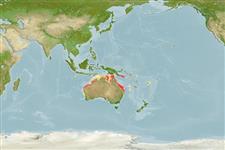Environment: milieu / climate zone / depth range / distribution range
Ecologia
marino demersale. Subtropical; 10°S - 32°S
Eastern Indian Ocean: Western Australia. Western Central Pacific: Queensland, Australia.
Size / Peso / Age
Maturity: Lm ? range ? - ? cm
Max length : 6.4 cm TL maschio/sesso non determinato; (Ref. 33839)
Body gibbous; greatest depth 37-40% SL; covered with highly modified scales, each with a small spinous point. Interorbital ridges thick and fused in the middle of interorbit. Dorsal margin of operculum inclined about 35° above horizontal (Ref. 39602).
Found on soft bottomed inshore areas.
Life cycle and mating behavior
Maturities | Riproduzione | Spawnings | Egg(s) | Fecundities | Larve
Paxton, J.R., D.F. Hoese, G.R. Allen and J.E. Hanley, 1989. Pisces. Petromyzontidae to Carangidae. Zoological Catalogue of Australia, Vol. 7. Australian Government Publishing Service, Canberra, 665 p. (Ref. 7300)
IUCN Red List Status (Ref. 130435)
Threat to humans
Harmless
Human uses
Pesce da pesca sportiva: si
Strumenti
Special reports
Download XML
Fonti Internet
Estimates based on models
Preferred temperature (Ref.
123201): 24.1 - 28.5, mean 26.7 °C (based on 214 cells).
Phylogenetic diversity index (Ref.
82804): PD
50 = 0.6250 [Uniqueness, from 0.5 = low to 2.0 = high].
Bayesian length-weight: a=0.00389 (0.00180 - 0.00842), b=3.12 (2.94 - 3.30), in cm total length, based on all LWR estimates for this body shape (Ref.
93245).
Trophic level (Ref.
69278): 3.3 ±0.3 se; based on size and trophs of closest relatives
Fishing Vulnerability (Ref.
59153): Low vulnerability (10 of 100).
